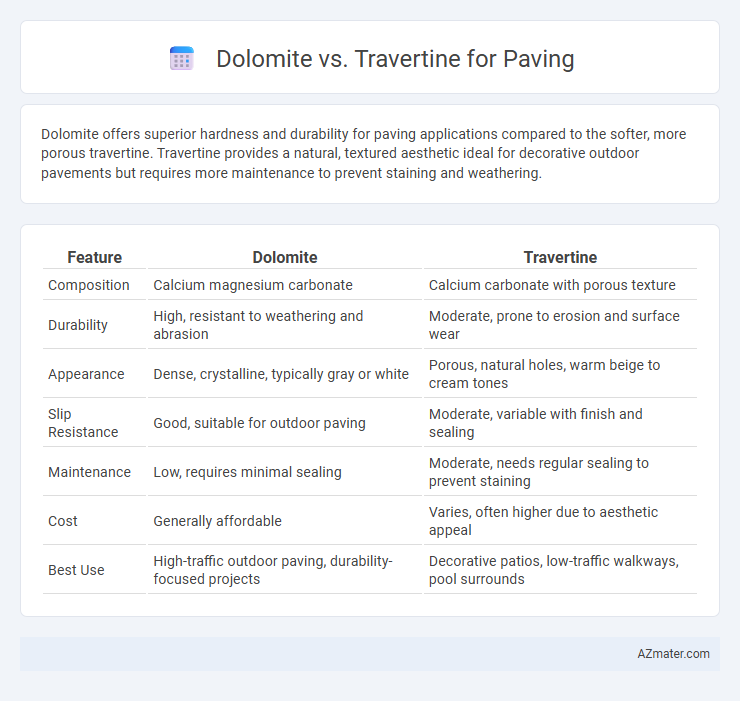Dolomite offers superior hardness and durability for paving applications compared to the softer, more porous travertine. Travertine provides a natural, textured aesthetic ideal for decorative outdoor pavements but requires more maintenance to prevent staining and weathering.
Table of Comparison
| Feature | Dolomite | Travertine |
|---|---|---|
| Composition | Calcium magnesium carbonate | Calcium carbonate with porous texture |
| Durability | High, resistant to weathering and abrasion | Moderate, prone to erosion and surface wear |
| Appearance | Dense, crystalline, typically gray or white | Porous, natural holes, warm beige to cream tones |
| Slip Resistance | Good, suitable for outdoor paving | Moderate, variable with finish and sealing |
| Maintenance | Low, requires minimal sealing | Moderate, needs regular sealing to prevent staining |
| Cost | Generally affordable | Varies, often higher due to aesthetic appeal |
| Best Use | High-traffic outdoor paving, durability-focused projects | Decorative patios, low-traffic walkways, pool surrounds |
Overview: Dolomite vs Travertine as Paving Materials
Dolomite offers a dense, durable surface with a smooth texture ideal for high-traffic paving areas, while travertine provides a natural, porous finish with distinctive veining that enhances aesthetic appeal. Dolomite's high compressive strength and resistance to abrasion make it suitable for heavy-duty outdoor applications, whereas travertine's slip-resistant qualities and warm color palette are favored for patios and pool surrounds. Both materials weather well, but travertine requires more maintenance due to its porous composition compared to the more resilient dolomite.
Composition and Origin: Dolomite and Travertine
Dolomite is a sedimentary carbonate rock primarily composed of the mineral dolomite (CaMg(CO3)2), formed through the alteration of limestone by magnesium-rich fluids. Travertine is a form of limestone deposited by mineral springs, especially hot springs, characterized by its porous texture and primarily composed of calcite (CaCO3). The distinct compositions and origins influence their durability and aesthetic suitability for paving projects, with dolomite offering greater hardness and travertine providing unique natural veining and colors.
Appearance: Color and Texture Differences
Dolomite paving showcases a wide range of earthy tones, including whites, grays, and subtle pinks, with a crystalline texture that offers a smooth, polished surface ideal for elegant outdoor spaces. Travertine presents warm beige, cream, and rust hues with a distinctive porous texture marked by natural pits and troughs, providing a rustic, slip-resistant finish perfect for pool decks and patios. The color consistency in Dolomite is more uniform, while Travertine's varied patterns create a natural, aged appearance that enhances Mediterranean or traditional architectural styles.
Durability and Strength Comparison
Dolomite exhibits higher durability and superior strength compared to travertine, making it more resistant to wear and heavy foot traffic in paving applications. Dolomite's dense crystalline structure offers excellent compression strength, whereas travertine's porous, sedimentary nature results in lower resistance to impact and weathering. For long-lasting paved surfaces, dolomite is typically preferred for its robustness and minimal maintenance requirements.
Slip Resistance and Surface Finish
Dolomite offers higher slip resistance due to its naturally textured surface, making it ideal for safer paving in wet or high-traffic areas. Travertine features a smoother, more porous surface with honed or polished finishes that provide elegance but may require sealing to improve grip. Choosing between dolomite and travertine for paving depends on balancing slip resistance needs with the desired aesthetic and maintenance level.
Weather and Climate Suitability
Dolomite offers superior durability and resistance to acid rain, making it ideal for regions with heavy rainfall and fluctuating temperatures. Travertine's porous structure is better suited for dry and moderate climates, as it can absorb moisture and may require sealing in wet conditions to prevent damage. Both materials provide excellent slip resistance, but dolomite withstands freeze-thaw cycles more effectively, ensuring longevity in colder climates.
Maintenance Requirements
Dolomite paving demands minimal maintenance due to its dense, non-porous structure, reducing susceptibility to stains and weathering. Travertine, being more porous, requires regular sealing and prompt cleaning to prevent discoloration and deterioration from moisture exposure. Both materials benefit from periodic sweeping and washing to preserve their appearance and enhance longevity.
Cost Comparison: Dolomite vs Travertine
Dolomite paving generally costs less than travertine due to its abundant availability and simpler extraction process. Travertine, prized for its unique porous texture and durability, commands higher prices influenced by quarrying complexity and processing time. Choosing between dolomite and travertine depends on budget considerations, with dolomite offering a more cost-effective option for large paving projects.
Environmental Impact and Sustainability
Dolomite paving stones are often favored for their durability and minimal environmental footprint, as quarrying dolomite tends to cause less habitat disruption and generates lower greenhouse gas emissions compared to travertine mining. Travertine, a form of limestone deposited by mineral springs, involves more intensive extraction processes that can lead to significant land degradation and water usage concerns, impacting ecosystems negatively. Choosing dolomite for paving aligns better with sustainable construction practices due to its abundant availability and lower resource consumption throughout production and transportation.
Best Applications for Each Stone Type
Dolomite offers exceptional durability and resistance to weathering, making it ideal for high-traffic outdoor paving such as driveways and walkways where strength is essential. Travertine excels in aesthetic appeal with its natural porous texture, making it a popular choice for patios, pool surrounds, and garden paths that benefit from slip resistance and elegant design. Choosing between Dolomite and Travertine depends on the desired balance between structural strength and decorative appearance for specific paving applications.

Infographic: Dolomite vs Travertine for Paving
 azmater.com
azmater.com